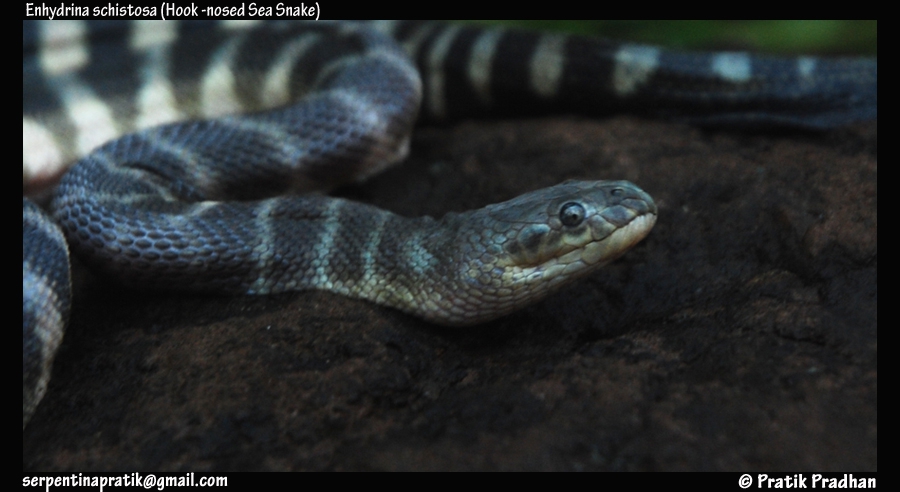| Citation |
|
Description |
Geographic Range [top]
Range Description: This species is found from the Arabian Gulf of Pakistan, India, and Sri Lanka, east to Australia and Papua New Guinea and north to Viet Nam (Heatwole 1999).
Countries occurrence:
Native:
Australia; Bahrain; Bangladesh; Cambodia; China; India (Andaman Is., Nicobar Is.); Indonesia; Iran, Islamic Republic of; Iraq; Kuwait; Malaysia; Myanmar; Oman; Pakistan; Papua New Guinea; Philippines; Qatar; Saudi Arabia; Singapore; Sri Lanka; Thailand; United Arab Emirates; Viet Nam
FAO Marine Fishing Areas:
Native:
Indian Ocean – western; Indian Ocean – eastern; Pacific – northwest; Pacific – western central
Additional data:
? Lower depth limit (metres): 30
Range Map: Click here to open the map viewer and explore range.
Population [top]
Population: This species is common throughout its range. It is very common along the coasts of the Malay Peninsula and less common in Australian waters. A mark-recapture study estimated between 600 and 2,000 juveniles of this species in the Muar River estuary in Malaysia in 1983. There were also estimates of 900-2,500 adults in the population of that area (Voris 1985).
Current Population Trend: Stable
Additional data:
? Population severely fragmented: No
Habitat and Ecology [top]
Habitat and Ecology: This species occurs in shallow open sea, river mouths, estuaries, coastal lagoons, and mangrove forests (Limpus 1975, Lim and Sawai 1975, Murthy 1977, Murthy and Rama Rao 1988, Venkateswarlu et al. 1995). It is found from 3.7-22.2 m (Redfield et al. 1978). It occurs over soft substrates such as mud and sand (Limpus 1975). It is also found in freshwater lakes in Cambodia and India, and can travel up rivers. It has been found at least 7 km upriver in Goa, India (A. Lobo pers. comm. 2009).
Common in near shore shallow waters and estuaries, especially in the soft bottom marine environments, where its preffered prey, catfish, occur in high abundances (A. Lobo pers. comm. 2009). Animals are active during the night and day and prefers water depth from less than 5 m to a maximum of 30 m (Leviton et al. 2003).
This species has displayed tightly synchronized annual reproductive cycles. It produces relatively large numbers of offspring with low effort per embryo (2%) (Lemen and Voris 1981). Clutch size increases with the size of the female and can reach 30 or more. The snakes are born with a snout-vent length of 21-24 cm, and grow at a rate of 0.1 cm per day for the first year. Females mature at around 18 months and produce a first clutch at around 24 months (Marsh et al. 1993, Voris and Jayne 1979). Between 10-20% of the species survive the first year and about 6% of females survive to reproduce. Snakes four years old or more make up a very small percentage of the population (Voris and Jayne 1979).
Systems: Freshwater; Marine
Use and Trade [top]
Use and Trade: This species is commonly collected for use in the anti-venom industry in Australia and Malaysia.
Threats [top]
Major Threat(s): This species is commonly encountered as bycatch in trawler as well as other fishing operations, for example along the Goa coast (Lobo et al. 2004). It appears to have a low trawl-related mortality rate (A. Lobo pers. comm. 2009). It is captured in trawl fisheries in Australia in more shallow waters where the trawl time is very short (15-20 minutes) and therefore the mortality is low (Courtney et al. 2010). There is evidence to suggest that post-release mortality may be high (A. Rasmussen and M. Guinea pers. comms. 2009).
Due to the nature of its habitat, this species is also likely to be impacted by coastal pollution.
Collection is thought to occur in high numbers in Thailand for the venom industry (A. Lobo pers. comm. 2009), but it is not known how this affects the population or if it is a major threat.
It is very abundant in shallow lagoons of Sri Lankas west coast, where they are frequently caught as bycatch and are a major cause of snake bite mortality among fishermen; for this reason they are usually deliberately killed before being removed from nets (K. Sanders and de Silva pers. comms. 2010).
Conservation Actions [top]
Conservation Actions: No sea snake species is currently listed by CITES (the Convention on International Trade in Endangered Species of Wild Fauna and Flora).
Sea snakes are protected in Australia since their addition to the ‘Listed Marine Species’ by the Department of Environment and Water Resources in 2000. They are protected in Australia under the Environment Protection Biodiversity and Conservation Act 1999. This requires that all Australian industries interacting with protected species, directly or indirectly, demonstrate sustainability for the species impacted by their activities (Milton et al. 2008).
Citation: Rasmussen, A., Sanders, K., Lobo, A. & Courtney, T. 2010. Enhydrina schistosa. The IUCN Red List of Threatened Species 2010: e.T176719A7289781. http://dx.doi.org/10.2305/IUCN.UK.2010-4.RLTS.T176719A7289781.en. Downloaded on 17 April 2017.
Disclaimer: To make use of this information, please check the .
Feedback: If you see any errors or have any questions or suggestions on what is shown on this page, please provide us with feedback so that we can correct or extend the information provided
|

